Do Recirculating Range Hoods Actually Work?
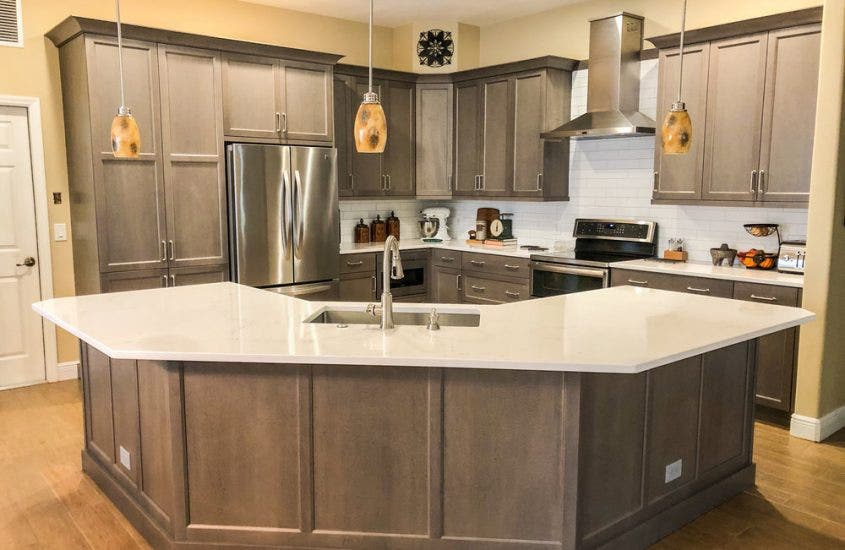
Yes. However, they are not as efficient as ducted range hoods that vent kitchen air to the outside of your home. Ductless range hoods use charcoal filters which trap some grease and odors but are not as effective as the stainless steel baffle and mesh filters of ducted range hoods.
Have you been shopping for a range hood? How will you vent it to the outside? If you are planning on purchasing a recirculating or ductless range hood, there are a few things you may want to consider.
As homeowners, we want to know that we are investing our money wisely. But if you are not familiar with range hoods and venting your kitchen, it’s hard to feel confident about choosing the right fan.
We’ll go over some of the best recirculating range hoods on the market. Then we’ll tell you everything you need to know about ductless range hoods.
Table of Contents
Best Recirculating Range Hoods
Most recirculating range hoods only run at 300 to 400 CFM or lower. At Proline, we offer powerful ductless hoods to ensure that your kitchen air remains clean and fresh.
Our ductless hoods pull an impressive 600 CFM of air, making them some of the most powerful on the market.
PLJW 185 Under Cabinet Range Hood
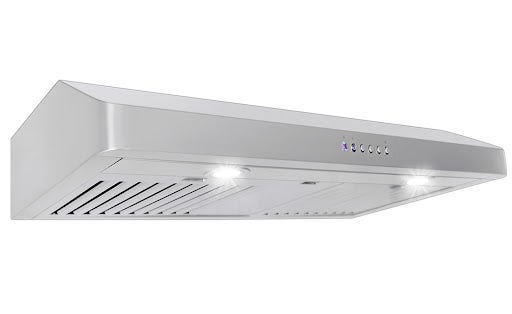
The PLJW 185 is one of our most popular recirculating range hoods. Customers love the sleek look, bright LED lights, and durable stainless steel finish. At just three inches tall, this hood packs a strong punch at 600 CFM. It’s a reliable low-profile fan that will last you years.
Click here for a list of our best under cabinet range hoods. Or if you don’t like the style of our beloved 185, check out a couple of alternatives below.
PLJW 520 Ductless Range Hood
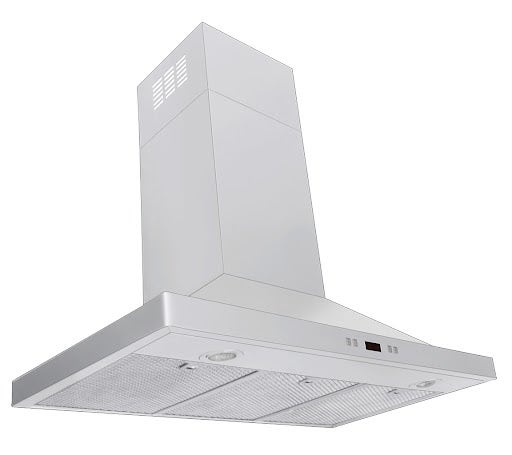
The PLFW 520 is a beautiful and powerful wall mounted vent hood. With your purchase of charcoal filters, you can convert this hood to ductless. It features a user-friendly control panel with a sleek digital display. On this panel, you can adjust the blower speed and LED lights easily while you’re cooking. The stainless steel mesh filters do a great job of capturing heavy grease and dirt before the air passes through the effective charcoal filters.
The 520 ductless vent hood is available in 24”, 30”, 36”, 42”, and 48” sizes.
Purchase your PLFW 520 wall vent hood at the link below.
PLFW 544 Ductless Range Hood
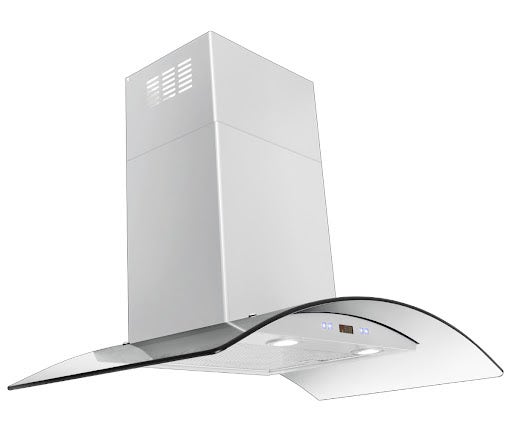
Closing out our list of the best ductless vent hoods is the PLFW 544. This vent hood features an innovative glass design that our customers love. Its unique design stands out from our other vent hoods with a stainless steel frame. Like the 185, the design isn’t its only perk. This model is rated at a powerful 600 CFM. Not only that, but there are six different speeds. The 544 truly accommodates any cooking style.
The PLFW 544 is complete with bright LED lights to help you see while in the kitchen as well as efficient stainless steel mesh filters to catch dirt and grease as it travels through your hood. The controls are modern and incredibly easy to use.
Buy your PLFW 544 ductless vent hood below.
Best Ductless Island Range Hoods
Do you need a ductless island hood for your kitchen? If so, you’re in luck. Our PLFW 520 and PLFW 544 models come as island hoods as well, with the exact same features. Check out some pictures below.
Mini Ductless Range Hood
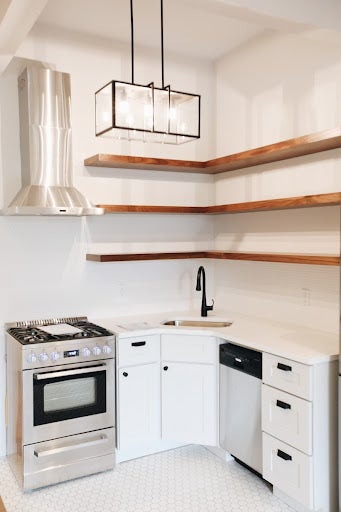
If you’re looking to remodel your small kitchen, we have the perfect vent hood for you: the 24” PLFW/PLFI 520. It has all the features of our 520 model and it is the smallest hood that we offer at Proline.
Recirculating Range Hood Inserts
If you’re in the market for a range hood insert, go with a ducted one rather than a recirculating insert. Professional quality recirculating inserts are hard to find – most that are on the market today are low-CFM compared to ducted inserts.
At Proline, we sell a wide variety of ducted vent hood inserts. Purchase yours below.
Recirculating Range Hoods for Gas Stoves
Generally, recirculating range hoods work well for electric stoves and gas stoves 36” or smaller. With a range over 36”, we don’t recommend mounting a recirculating hood since most gas stoves produce too many BTUs for a ductless hood to handle.
We wrote a comprehensive article on the best vent hoods for gas stoves. For more information, check it out here!
Ductless Range Hood Installation
If you don’t have the budget to spend money on installation, no problem. You don’t need a professional to install your recirculating hood. Check out our video on how to install the ductless PLFW 520 below. This installation is similar to many other ductless hoods available on the market today.
How to Install a Ductless Island Range Hood
Here’s a closer look at how to install a ductless island range hood – our PLFI 520.
How to Clean a Ductless Range Hood
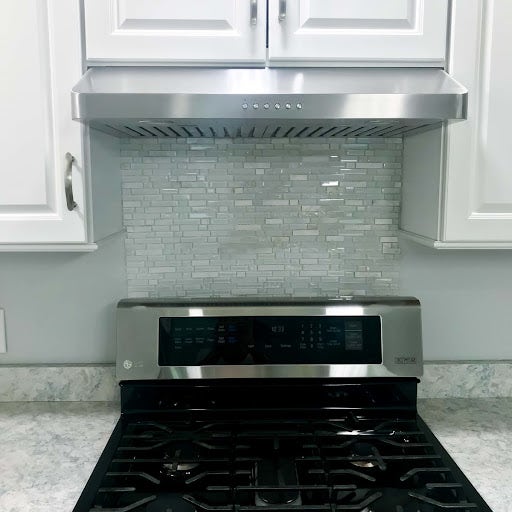
- Apply glass cleaner or acetone to a towel.
- Wipe the surface of your vent hood.
- If the stains don’t come off, apply a small amount of no grit Soft Scrub to a towel and wipe the hood off. This is a last resort.
- Remove your stainless steel filters
- Unscrew the blower from the vent hood.
- Unscrew side of blower to remove charcoal filters.
- Replace charcoal filters (click here to find out how often to replace them)
Ductless Range Hood Reviews
Check out some reviews from Proline Range Hoods’ customers below. For more reviews, check out this article.
“I love how slim and sleek it is! It’s super powerful and the buttons on top make it easy to use. I am so happy to have a great quality range hood!” – Shane C.
“The range hood we purchased is extremely well made and straightforward to install. The instructions were easy to follow and we had no problems doing the installation ourselves. We are very happy with the functionality of the hood and would purchase from Proline again.” – Patty T.
“I love my range hood, especially the lights on it. The ventilation is amazing. I could not ask for anything more out of it.” – Nick L.
“We own a PLJW 185.30 under cabinet range hood purchased in 2017. Its dual fan, variable speed settings, sleek look, and unique profile to fit into a corner space made it the ideal choice. The ease of cleaning, both the outer hood and the grills, along with its ability to clear cooking gases quickly and without a lot of noise makes us proud to keep it in our kitchen! We are super happy with this choice and would highly recommend the products to anyone. The customer service is also very attentive and works with you to get a resolution. They are clearly proud of the products they make.” – Jay S.
What is a ductless range hood?
A ductless range hood is a kitchen exhaust fan that recirculates your kitchen air through charcoal filters instead of ductwork. Charcoal filters trap grease, dirt, and neutralize odors. Then, the air vents back into the kitchen.
How does a ductless range hood work?
A ductless range hood works by sucking greasy kitchen air through mesh or baffle filters. Once the air passes through these filters, it moves through carbon filters that trap dirt and neutralize strong cooking odors. Ductless range hoods improve your indoor air quality, but they are not as effective as ducted range hoods.
Are ductless range hoods worth it?
It depends on the person. In general, a ductless range hood is better than no range hood. Ductless range hoods can be installed on your wall, over a kitchen island, or inside a custom range hood. They are also a cost-effective option for your kitchen, since you don’t have to pay a contractor to install ductwork. Ductless hoods are not as efficient as ducted hoods, which move kitchen air through ductwork to the outside.
Why do most people prefer to vent kitchen hoods to the outside?
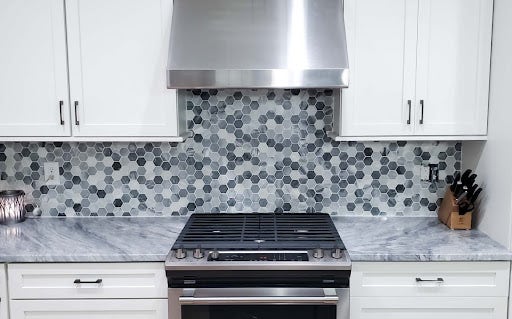
Venting kitchen hoods to the outside is becoming more common. Outdoor venting is much more efficient for getting rid of smoke, steam, and other chemicals in the air.
When installing a ducted exhaust fan, find an area near any pipes or ducts that reach to the outside. Many people who have homes without designated venting areas find a professional to install ventilation.
While ducted hoods vent air to the outside, ductless or recirculating hoods simply recirculate the air throughout your kitchen.
Why use a ductless range hood?
Ductless Range Hood Benefits
There are a few clear benefits to having a ductless range hood, including the inexpensive price and ease of installation. However, when it comes to the health, safety, and cleanliness of your home, most people prefer to vent their kitchen hoods to the outside.
Ductless Range Hood Drawbacks
Recirculating hoods also have their disadvantages. Recirculating hoods simply recirculate air inside the home instead of pulling the greasy cooking exhaust and venting it outside the home, which is never ideal.
A recirculating hood can also be noisier than ducted models; they often require much more fan power. It is also important to remember that the filter needs to be cleaned or replaced regularly to keep the hood functioning well, which is a continuing cost for the homeowner.
What are some common health concerns of poor kitchen ventilation?
When it comes to poor kitchen ventilation, there are many health concerns. A shocking 80% of all cancers are attributed to environmental rather than genetic factors. This includes exposure to cancer-causing chemicals. Many of these toxic chemicals are found in household cleaning products.
According to the Environmental Protection Agency (EPA), indoor environments are two to five times more toxic than outdoor environments. In some cases, indoor air in homes is 100 times more polluted. This would not be as concerning if we didn’t spend so much time inside our homes. However, people spend approximately 90 percent of their time indoors. For these reasons, kitchen ventilation is vital to your health and safety.
Here are a few things that may be in your air at home:
- Carbon Monoxide – If you have a gas range, you may be putting elevated levels of carbon monoxide in your air.
- Formaldehyde – One of the chemicals produced from heating oil.
- Other Toxins – Grease, food, and house cleaners burning on your stove create more airborne toxins. This is not healthy for anyone’s everyday living and breathing environment.
- Moisture/Steam – Cooking can put a lot of water vapor into the air.
- Odors – You know those fish tacos you made the other night? Well, your guests might be smelling that for a while.
Recap – Ductless vs. Ducted Range Hoods (Ventless vs. Vented)
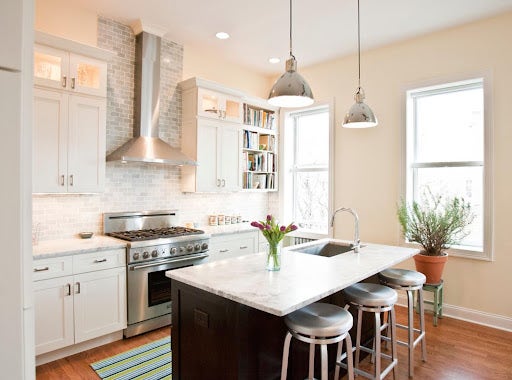
As you can see, there are many reasons why people prefer vented kitchen hoods over ventless kitchen hoods.
A ducted hood will always be much more effective at filtering all forms of air pollution produced from cooking out of your home. It removes greasy kitchen air and also prevents cooking odors from spreading throughout the house. With a ductless vent hood, the air is filtered and released back into the room only using a charcoal filter for cleaning.
Keep in mind that having a kitchen hood that recirculates is better than not having a vent hood at all. A ductless vent hood is easy to set up, but it won’t give you the same performance as kitchen hoods that are vented to the outside.
For more details about the pros and cons of ducted and ductless hoods, check out our complete article here.
Are ductless range hoods safe?
Yes, ductless range hoods are safe to use in your kitchen. However, if you cook often or love greasy or Asian cooking, a ductless hood will not have enough power to vent your hood to the outside. This could result in poor indoor air quality which is unsafe for your long-term health and especially dangerous to those with pre-existing lung or breathing conditions.
Depending on your cooking style, you may want to go with a more powerful 900 CFM hood – or even 1200 CFM.
What is the quietest range hood?
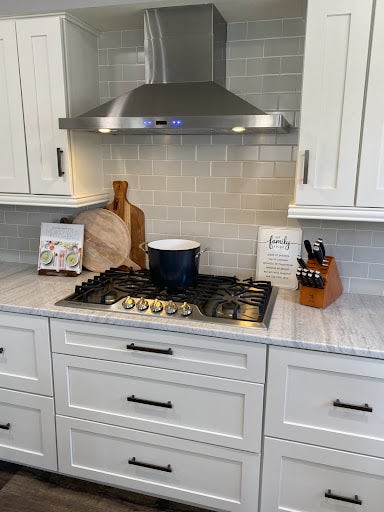
The quietest range hood is our PLFW 520, which runs at just 4.5 sones at max power.
If you prefer a glass vent hood, our PLFW 544 is also incredibly quiet at 4.5 sones.
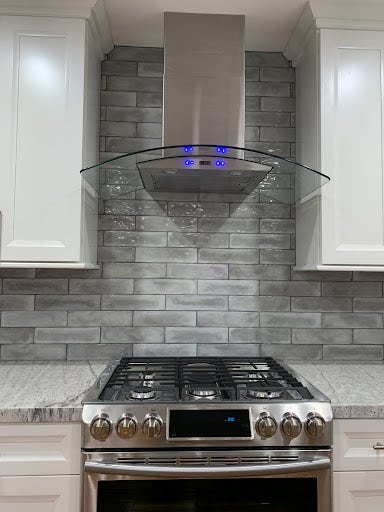
What is the difference between a recirculating and convertible range hood?
A recirculating range hood recirculates your kitchen air; it does not come with ductwork. In contrast, a convertible range hood is initially ducted. But, with your purchase of a recirculating kit or charcoal filters, you can convert the hood from ducted to ductless.
For more information on convertible hoods and why they might be right for you, check out this article.
How do I know if I have a ductless range hood?
The most obvious way to determine if your range hood is ductless is whether or not you have ductwork. If you have no ductwork, your hood recirculates kitchen air. Also, if your vent hood comes with carbon filters or a recirculating kit, it is ductless.
How much does it cost to install a ductless range hood?
On average, a ductless range hood costs between $100 and $300 to install. It is less expensive than installing a ducted hood since you don’t need ductwork. This also makes the job much more doable for the DIYers out there.
How do I make my cooker hood quieter?
There are two primary ways you can make your cooker hood quieter:
- Run it on lower speeds
- Install an inline blower inside your ductwork.
Running the range hood on lower speeds will cut down on the noise level significantly. The hood will be even quieter if you can install an inline blower, which sits inside your ductwork rather than inside the range hood. The noise comes from your blower or blowers, so the further away they are, the quieter your range hood will be.
Note that not all range hoods are compatible with inline blowers. Be sure to double check with the manufacturer or view the product page to determine if the hood is compatible before purchase.
How do I choose a quiet range hood?
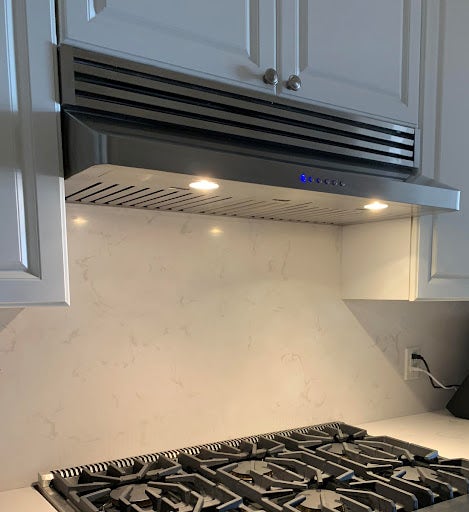
To choose a quiet range hood, consider the following:
- Noise Level
- CFM
- Cooking Habits
- Variable Speed
- Style
Noise Level
The first step is to determine how quiet you want your range hood. It is measured in sones, which you can learn more about here. The quietest ones are around three sones, and some are even quieter. But they don’t have a lot of power.
CFM
Speaking of power, CFM is another important aspect of your hood to consider. As CFM increases, the noise level of your hood increases. It’s up to you to find a balance between noise level and fan power.
Here are a few questions to help you find the perfect balance.
- How often do you cook?
- Do you like to socialize with people in the kitchen?
- Are you particularly irritated by noise while cooking?
Cooking Habits
Keep your cooking habits in mind when deciding how quiet you want your fan. Essentially, more frequent cooks will have to sacrifice some noise level for the power of their kitchen fan. If you need a powerful hood, try to find one that uses an inline blower, which will significantly reduce the noise level.
If you don’t cook often, you can choose a hood as quiet as you’d like.
Variable Speed
When shopping for a quiet exhaust fan, consider one that has variable speed. This gives you a ton of flexibility in the kitchen. You can run your hood on lower speeds to enjoy significantly lower noise levels.
Style
Regardless of noise level, your vent hood won’t be the one for you if you don’t like the style.
Depending on the manufacturer, you may not have many options if you’re looking for an ultra-quiet hood.
At Proline, we have several quiet hoods for your kitchen: island hoods, wall hoods, glass hoods, and much more.
Recap
This concludes our guide on recirculating vent hoods. Hopefully this information has been helpful.
Are you shopping for a ductless hood? Check out our professional quality selection of ductless hoods here.
If you’re looking for information on ducted hoods as well, check out this article.
Thanks for reading!
Related Articles
Best Range Hoods for Gas Stoves
Best Range Hood for Asian Cooking
Best Range Hood for Your Apartment
Do recirculating range hoods actually work?
Yes. However, they are not as efficient as ducted range hoods that vent kitchen air to the outside of your home. Ductless range hoods use charcoal filters which trap some grease and odors but are not as effective as the stainless steel baffle and mesh filters of ducted range hoods.
What is a ductless range hood?
A ductless range hood is a kitchen exhaust fan that recirculates your kitchen air through charcoal filters instead of ductwork. Charcoal filters trap grease, dirt, and neutralize odors. Then, the air vents back into the kitchen.
How does a ductless range hood work?
A ductless range hood works by sucking greasy kitchen air through mesh or baffle filters. Once the air passes through these filters, it moves through carbon filters that trap dirt and neutralize strong cooking odors. Ductless range hoods improve your indoor air quality, but they are not as effective as ducted range hoods.
Why do most people prefer to vent kitchen hoods to the outside?
Venting kitchen hoods to the outside is becoming more common. Outdoor venting is much more efficient for getting rid of smoke, steam, and other chemicals in the air.
When installing a ducted exhaust fan, find an area near any pipes or ducts that reach to the outside. Many people who have homes without designated venting areas find a professional to install ventilation.
While ducted hoods vent air to the outside, ductless or recirculating hoods simply recirculate the air throughout your kitchen.
Why use a ductless range hood?
There are a few clear benefits to having a ductless range hood, including the inexpensive price and ease of installation. However, when it comes to the health, safety, and cleanliness of your home, most people prefer to vent their kitchen hoods to the outside.
Recirculating hoods also have their disadvantages. Recirculating hoods simply recirculate air inside the home instead of pulling the greasy cooking exhaust and venting it outside the home, which is never ideal.
A recirculating hood can also be noisier than ducted models; they often require much more fan power. It is also important to remember that the filter needs to be cleaned or replaced regularly to keep the hood functioning well, which is a continuing cost for the homeowner.
What are some common health concerns of poor kitchen ventilation?
When it comes to poor kitchen ventilation, there are many health concerns. A shocking 80% of all cancers are attributed to environmental rather than genetic factors. This includes exposure to cancer-causing chemicals. Many of these toxic chemicals are found in household cleaning products.
According to the Environmental Protection Agency (EPA), indoor environments are two to five times more toxic than outdoor environments. In some cases, indoor air in homes is 100 times more polluted. This would not be as concerning if we didn’t spend so much time inside our homes. However, people spend approximately 90 percent of their time indoors. For these reasons, kitchen ventilation is vital to your health and safety.
Are ductless range hoods safe?
Yes, ductless range hoods are safe to use in your kitchen. However, if you cook often or love greasy or Asian cooking, a ductless hood will not have enough power to vent your hood to the outside. This could result in poor indoor air quality which is unsafe for your long-term health and especially dangerous to those with pre-existing lung or breathing conditions.
What is the quietest range hood?
How do I make my cooker hood quieter?
There are two primary ways you can make your cooker hood quieter:
1. Run it on lower speeds
2. Install an inline blower inside your ductwork.
Running the range hood on lower speeds will cut down on the noise level significantly. The hood will be even quieter if you can install an inline blower, which sits inside your ductwork rather than inside the range hood. The noise comes from your blower or blowers, so the further away they are, the quieter your range hood will be.
Note that not all range hoods are compatible with inline blowers. Be sure to double check with the manufacturer or view the product page to determine if the hood is compatible before purchase.
What is the difference between a recirculating and convertible range hood?
A recirculating range hood recirculates your kitchen air; it does not come with ductwork. In contrast, a convertible range hood is initially ducted. But, with your purchase of a recirculating kit or charcoal filters, you can convert the hood from ducted to ductless.
For more information on convertible hoods and why they might be right for you, check out this article.
How do I choose a quiet range hood?
To choose a quiet range hood, consider the following:
Noise Level
CFM
Cooking Habits
Variable Speed
Style
How do I know if I have a ductless range hood?
The most obvious way to determine if your range hood is ductless is whether or not you have ductwork. If you have no ductwork, your hood recirculates kitchen air. Also, if your vent hood comes with carbon filters or a recirculating kit, it is ductless.
How much does it cost to install a ductless range hood?
On average, a ductless range hood costs between $100 and $300 to install. It is less expensive than installing a ducted hood since you don’t need ductwork. This also makes the job much more doable for the DIYers out there.
Are ductless range hoods worth it?
It depends on the person. In general, a ductless range hood is better than no range hood. Ductless range hoods can be installed on your wall, over a kitchen island, or inside a custom range hood. They are also a cost-effective option for your kitchen, since you don’t have to pay a contractor to install ductwork. Ductless hoods are not as efficient as ducted hoods, which move kitchen air through ductwork to the outside.




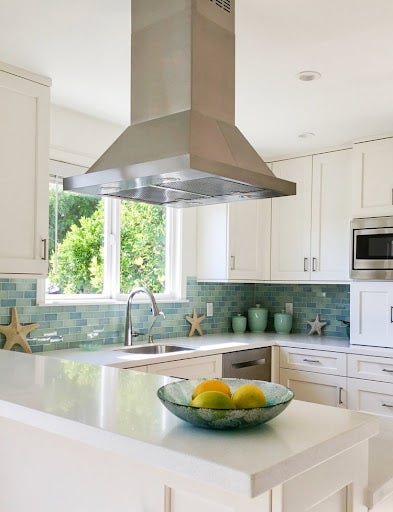
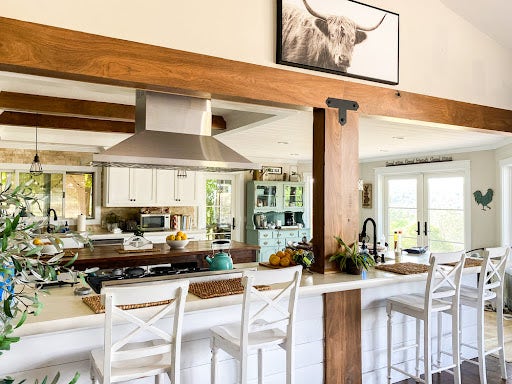
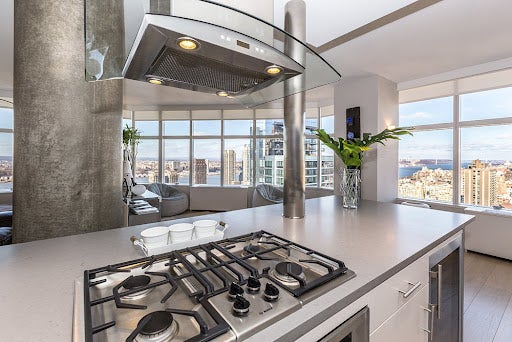
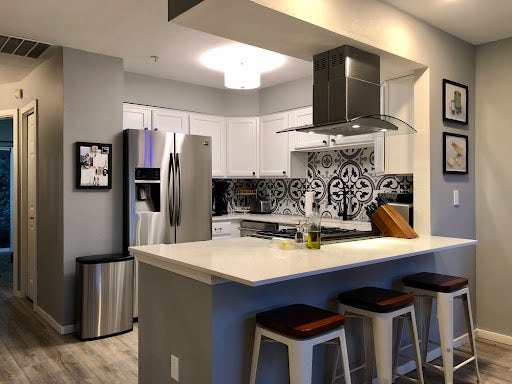

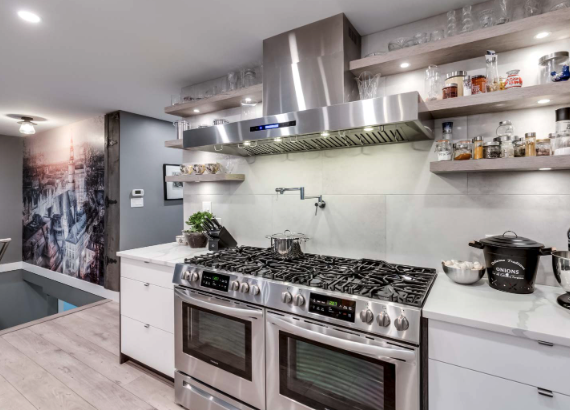
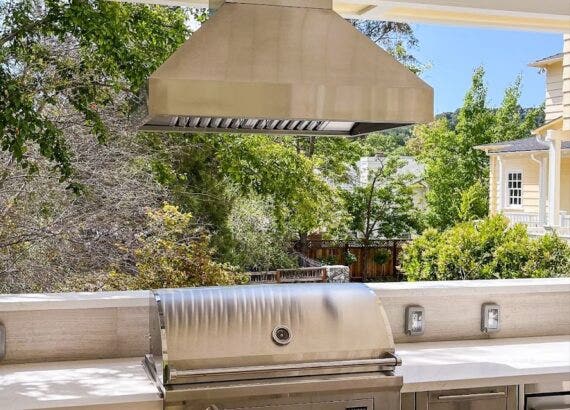
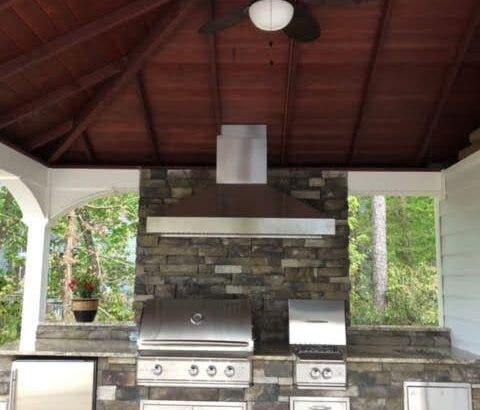
Comments are closed.